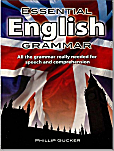

| Book of the Month | ||
 |
Essential English Grammar |  |
Publisher: Dover Publications
Author: Philip Gucker
$6.75
ISBN 0486216497
The sub-title of this book is 'All the grammar really needed for speech and comprehension'. What is interesting about this book is that it is clearly written for users who are able to speak and comprehend English very well to start with. Therefore advanced English is used to describe simple grammar such as that used in forming questions. The reason for the simple grammar and sophisticated language is that target users of this book are not non-native speakers but people who have been speaking English all their lives. Because of a bizarre failure in the education system, these people have never been taught grammar. It may amaze those who have received thorough instruction in the grammar of their own language, but the fact is that few English speakers can distinguish between more than nouns and verbs. Gerunds, present perfects and verb auxiliaries are far better known to ESL students than to native English speakers. As a result many English speakers know that they might be using faulty grammar, but do not have the language tools to even start fixing the problem. This book has been written to help these people.
The book is divided into three parts (four parts if you include the ten-page catalogue of this publisher's products at the back). Part one introduces the 'Essentials of English Grammar' or what would be called syntax if those people using the book had been taught the meaning of that word. This is the basics of what is needed to put together a well-formed sentence, whether that sentence is a question, an order or a statement. So we learn of things like subject and predicate. (A subject tells us what the sentence is about, the predicate tells us about the subject. With 'Jac is French'; 'Jac' is the subject 'is French' is the predicate.) Because the author is writing for people who already understand English (but not how it works) the text moves very quickly on to things like compound sentences and verb complements. If you are not sure that you are keeping up, there are regular practice tests to measure your progress. Part two of the book 'Putting Grammar to Work' is actually very much like part one, but the grammar gets more complex. Also there is now more stress on matters such as getting the tense and mood of a sentence correct, arranging sentences so that they have a logical internal structure and putting modifers in the correct place. Because all this is packed into 150 pages - part three is the answers to the practice tests - the explanations have to be short and examples few. However the explanations are very clear, and the lack of pictures leaves more room for text. The book is also well laid out so that the explanations have a logical order. However, there seems no reason why the 'dictionary of grammatical terms' is on p.87 rather than at the beginning or the end of the book. The end of the book also has an index which is not really needed, both because of the dictionary halfway through and the detailed chapter descriptions at the beginning.
Who is this book for? The target reader is a native English speaker from 'the generation that grammar forgot'. In England there is now an attempt to start teaching formal grammar again, but the problem is that many teachers also do not know it. This book is for them, or anyone who needs to know why sentences should properly be written in a certain way. An advanced EFL student will also find this book useful as a quick revision of the grammar learned in previous years, and as a guide to using well-formed sentences.
Verdict: A book that meets an urgent need.
Assessment 8/10